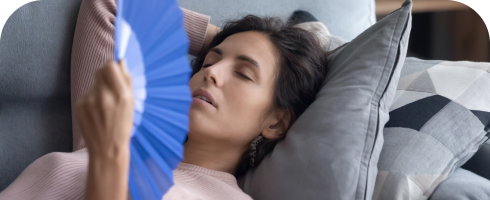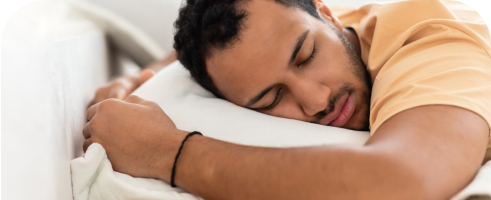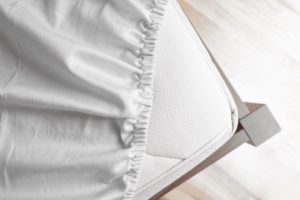How Many Pillows Should You Sleep With?
Pillows play an important role in helping you get a good night’s sleep. Your pillow works in conjunction with your sleeping position and mattress to impact sleep posture. If your spine is misaligned during sleep, you may wake up with aches and pains the next morning.
While many people only require one pillow under their head, it needs to be the right pillow based on their sleep position and body type. We’ll review how to choose the best pillow and discuss some situations where sleepers may prefer using multiple pillows.
Find a Pillow That’s Right for You
Looking for a new pillow? Take the quiz below to find the perfect pillow for your needs.
Trouble sleeping?
Answer these 5 easy questions to discover your perfect pillow

Trouble sleeping?
Answer these 5 easy questions to discover your perfect pillow
What position do you sleep in?

Side

Back

Stomach
How to Find the Right Pillow
The right pillow should support your sleeping position and keep your spine aligned while you sleep. In the bedding industry, the height or thickness of a pillow is called its loft. If a pillow is too thin or too thick for a particular sleeper, it could cause their neck to rest in an unnatural position and result in discomfort.
Pillow lofts generally fall into one of three categories:
- Low loft: Less than 3 inches
- Medium loft: 3 to 5 inches
- High loft: More than 5 inches
While individual needs vary, there are some general guidelines for pillow loft based on sleep position.
Side Sleepers
Side sleepers generally prefer a high-loft pillow for appropriate support in the space between their head and shoulders. Memory foam pillows can be a great option since they provide a supportive cradle for the head and neck.
“Side sleepers tend to need a high-loft pillow for support and to fill the space beneath the head and neck to promote proper spinal alignment. Keep your head and neck in alignment at around 30 degrees with the help of a good pillow so your airway stays open during the night, allowing air to flow from your nose to your lungs without obstruction.”
– Sarah Silverman, Psy.D., a licensed psychologist and holistic sleep wellness consultant who treats patients in New York and Florida.
Back Sleepers
Back sleepers typically do well with a mid-loft pillow that is just thick enough to keep the neck aligned with the spine. Some back sleepers enjoy orthopedic pillows with a curved indent for the head since they provide more support beneath the neck, with a concave area for the head to rest.
Stomach Sleepers
People who sleep on their stomach usually prefer a very thin pillow, though some stomach sleepers opt to use no pillow at all. If a pillow is too thick, it uncomfortably forces a stomach sleeper’s neck up and backward toward the spine. Sleeping without a pillow can help stomach sleepers keep their spine as straight as possible.
Body Type Considerations
Besides sleep position, your body type can also influence which pillow loft and firmness you prefer. People who weigh under 130 pounds put less pressure on a pillow than heavier individuals, so they may prefer a softer model with a lower loft. On the other hand, sleepers over 230 pounds exert more pressure and may find that a soft pillow compresses too deeply.
Keep in mind that pillows can lose their loft over time and typically need to be replaced every few years.
Sleeping With Multiple Pillows
Although many people just need one pillow to sleep, sometimes there are circumstances where sleepers may feel better supported by multiple pillows.
- Pillow between the knees: Side sleepers may find comfort and better sleep posture from an additional pillow placed between their knees. Some pillow manufacturers make models specifically intended for this purpose, with ergonomic shapes designed to fit snugly between the knees.
- Pillow under the knees: Some back sleepers find relief from lower back pain by using a pillow underneath their knees. This is especially helpful when there is a gap between the small of the back and the mattress surface. By placing a pillow under the knees, it elevates the knees slightly, encouraging the lumbar region to sink deeper into the mattress and thus straightening the spine.
- Pillows for back pain: Sleepers with back pain may benefit by sleeping on their side with a pillow between their knees. Alternatively, they may be more comfortable sleeping on their back with a pillow under their knees to relieve pressure.
- Body pillows: Though body pillows can vary significantly in shape and fill materials, most are at least 48 inches long. U-shaped and C-shaped body pillows are often used during pregnancy, while rectangular designs can benefit side sleepers who like to cradle a pillow against their body.
- Pregnancy pillows: Many pregnant people avoid sleeping on their back and may have difficulty finding a comfortable sleep position. A supportive body pillow can help keep pregnant sleepers on their side, while smaller wedge pillows can provide targeted support to areas like the midsection, back, or knees.

Still have questions? Ask our community!
Join our Sleep Care Community — a trusted hub of sleep health professionals, product specialists, and people just like you. Whether you need expert sleep advice for your insomnia or you’re searching for the perfect mattress, we’ve got you covered. Get personalized guidance from the experts who know sleep best.























